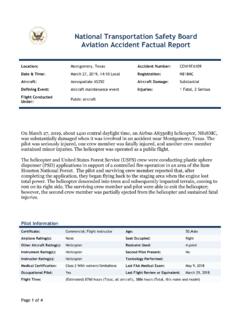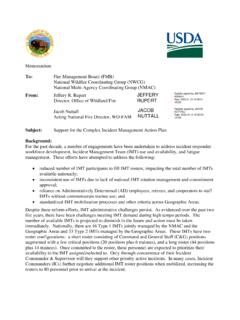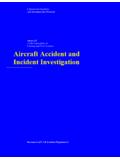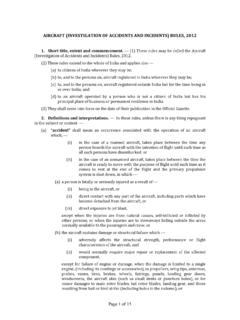Transcription of Yarnell Hill Fire - Wildfire Today
1 Yarnell hill fire June 30, 2013 serious Accident investigation Report September 23, 2013 Cover Photo: Raising the United States and State of Arizona flags at the Granite Mountain crew s deployment site. Courtesy of the Southwest Area Type 1 Incident Management Team. In Memory Of Andrew Sterling Ashcraft Robert E. Caldwell Travis Clay Carter Dustin James DeFord Grant Quinn McKee Sean M. Misner Christopher A. MacKenzie Eric S. Marsh Scott Daniel Norris Wade S. Parker John J. Percin, Jr. Anthony M. Rose Travis Turbyfill William Howard Billy Warneke Jesse James Steed Joe B. Thurston Clayton Thomas Whitted Kevin J. Woyjeck Garret Zuppiger Yarnell hill fire serious Accident investigation i Contents Executive Summary .. 1 The investigation Process .. 5 Background .. 8 Part One: Factual & Management Report.
2 11 Narrative .. 11 Friday, 28 June 2013 .. 11 Saturday, 29 June 2013 .. 12 Sunday, 30 June 2013 .. 15 Summary .. 31 Analysis .. 33 Conclusions .. 41 Recommendations .. 44 Part Two: Learning Discussion .. 45 Discussion .. 45 Sensemaking Frame .. 46 Situational Awareness .. 47 Fireline Safety .. 50 Communications .. 55 Incident 58 Improving Resilience .. 60 Charge to the Wildland fire Community .. 60 Appendices .. 61 Appendix A: Sequence of Events .. 61 Appendix B: fire Environment & Behavior Analysis .. 65 Appendix C: Personal Protective Equipment Analysis .. 82 Appendix D: Aviation Summary .. 96 Appendix E: Work/Rest & Qualifications Summary .. 105 Appendix F: fire Acronyms & Terminology .. 108 Appendix G: Delegation of Authority .. 112 Appendix H: Team Members & Signature Page .. 113 Appendix I: Subject Matter Experts .. 115 Appendix J: Acknowledgements .. 116 Yarnell hill fire serious Accident investigation ii Yarnell hill fire serious Accident investigation 1 Executive Summary Nineteen firefighters died on the Yarnell hill fire in central Arizona on June 30, 2013 after deploying fire shelters.
3 They were members of the Granite Mountain Interagency Hotshot Crew (IHC), hosted by the Prescott fire Department. One crewmember was separated from the crew earlier that day and was not at the deployment site. * * * * * Late afternoon on June 28, the Yarnell hill fire started high on a ridge west of Yarnell , Arizona when lightning ignited multiple fires. The fire , which was under the jurisdiction of the Arizona State Forestry Division, started in a boulder field in steep terrain with no vehicle access; it was about one-half acre in size. Responders saw minimal fire activity or spread potential, and they had several safety concerns with putting firefighters on the hill overnight. In consideration of these and other factors, the Incident Commander prepared for full suppression on the following morning. On June 29, resources held the fire in check until around 1600, when winds increased and the fire spotted outside containment lines. That evening, the Type 4 Incident Commander ordered a Type 2 Incident Management Team (IMT) and additional resources for the next morning.
4 The fire grew throughout the night, to an estimated 300 to 500 acres by morning. Early on June 30, members of the Type 2 IMT began arriving. In a briefing at 0700, the incoming Granite Mountain IHC Superintendent accepted the role of Division Alpha Supervisor. His assignment was to establish an anchor point at the heel of the fire with the Granite Mountain IHC. The Type 2 IMT assumed command, an action formally announced by radio at 1022. For most of the day, the fire spread to the northeast, threatening structures in Model Creek and Peeples Valley. Around 1550, the wind shifted and the fire started pushing aggressively to the southeast, toward Yarnell . fire resources shifted to resident evacuation and structure protection in town. Only the Granite Mountain IHC remained out on the ridge, on the southwest perimeter of the fire . Personnel who communicated with the Granite Mountain IHC knew the crew was in the black at that time and assumed they would stay there.
5 No one realized that the crew left the black and headed southeast, sometime after 1604. At 1630, thunderstorm outflows reached the southern perimeter of the fire . Winds increased substantially; the fire turned south and overran the Granite Mountain IHC at about 1642. * * * * * There is a gap of over 30 minutes in the information available for the Granite Mountain IHC. From 1604 until 1637, t he Team cannot verify communications from the crew, and we have almost no direct information for them. There is much that cannot be known about the crew s decisions and actions prior to their entrapment and fire shelter deployment at around 1642. Yarnell hill fire serious Accident investigation 2 It is known that the Granite Mountain IHC left the black sometime after 1604 and traveled through an unburned area toward a safety zone at the Boulder Springs Ranch. Thunderstorm outflows changed the intensity and direction of fire spread, and the rapidly advancing fire eliminated the crew s options of reaching the safety zone or returning to the canyon rim.
6 They had less than two minutes to improve a deployment site. They were deploying fire shelters when the fire overtook them. Temperatures exceeded 2000oF, and the deployment site was not survivable. The nineteen crewmembers were found approximately one mile south-southeast of their last known location, approximately 600 yards west of the Ranch. * * * * * The State of Arizona convened a serious Accident investigation Team. A delegation of authority letter, signed by the State Forester on July 3, 2013, charged the Team with reviewing and reporting on the circumstances leading to entrapment of the Granite Mountain IHC. The Team used a variety of data sources and methods to reconstruct events and analyze them. In deliberations, the Team drew from their knowledge of wildland fire operations and culture, as well as the perspectives of Subject Matter Experts. Through these processes, the Team generated the following conclusions: The Granite Mountain IHC was a fully qualified, staffed, and trained hotshot crew.
7 They were current with the required training and met work/rest guidelines. The crew followed all standards and guidelines as stated in the Standards for Interagency Hotshot Crew Operations and the Arizona State Forestry Division s Standard Operational Guideline 804. The Yarnell hill area had not experienced Wildfire in over 45 years. It was primed to burn because of extreme drought, decadent chaparral, and above average cured grass loadings. Although Yavapai County had a Community Wildfire Protection Plan, many structures were not defendable by firefighters responding to the Yarnell hill fire . The fire destroyed over one hundred structures. Radio communications were challenging throughout the incident. Some radios were not programmed with appropriate tone guards. Crews identified the problem, engaged in troubleshooting, and developed workarounds so they could communicate using their radios. Radio traffic was heavy during critical times on the fire .
8 The fire s complexity increased in a very short time, challenging all firefighting resources to keep pace with the rapidly expanding incident. As complexity dramatically increased starting Saturday evening, fire management went through multiple transitions from a Type 4 through a Type 1 incident in fewer than 20 hours. The Granite Mountain IHC had been watching the active fire burn away from their position all day but their observations did not lead them to anticipate the approaching outflow boundary or the accompanying significant fire behavior changes. These changes Yarnell hill fire serious Accident investigation 3 included a doubling of fire intensity and flame lengths, a second 90-degree directional change, and a dramatically accelerated rate of spread. The Granite Mountain IHC left the lunch spot and traveled southeast on the two-track road near the ridge top. Then, they descended from the two-track road and took the most direct route towards Boulder Springs Ranch.
9 The Team believes the crew was attempting to reposition so they could reengage. The Granite Mountain IHC did not perceive excessive risk in repositioning to Boulder Springs Ranch. The Team found no indication that the Granite Mountain IHC doubted the black was a valid safety zone, or that they moved towards the Boulder Springs Ranch because they feared for their safety if they stayed in the black. Although much communication occurred among crews throughout the day, few people understood Granite Mountain s intentions, movements, and location, once they left the black. The Team believes this is due to brief, informal, and vague radio transmissions and talkarounds that can occur during wildland fire communications. Based on radio conversations, Operations and other resources had concluded the Granite Mountain IHC was located in the black, near the ridge top where they had started that morning. This resulted in confusion about the crew s actual location at the time of search and rescue.
10 In retrospect, the importance of the 1526 weather update is clear. However, the update appears to have carried less relevance in the crew s decision-making process, perhaps due to the wind shift (starting at about 1550) that preceded the outflow boundary, or perhaps because of the time it took the outflow boundary to reach the south end of the fire (at 1630). It is possible they may have interpreted the early wind shift as the anticipated wind event. An Air Attack and/or an Aerial Supervision Module provided aerial supervision coverage throughout the day including at the time of the accident. The Aerial Supervision Module working the fire was very busy fulfilling leadplane duties, which limited their ability to perform full Air Attack responsibilities over the fire at the same time. During some limited times, aircraft were not available due to adverse weather and refueling needs. At the time of the shelter deployment, a Very Large Airtanker was on station over the fire waiting to drop retardant as soon as the crew s location was determined.












